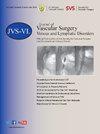通过影像辅助序贯治疗优化静脉畸形的治疗选择:一个病例系列分析。
IF 2.8
2区 医学
Q2 PERIPHERAL VASCULAR DISEASE
Journal of vascular surgery. Venous and lymphatic disorders
Pub Date : 2025-04-22
DOI:10.1016/j.jvsv.2025.102250
引用次数: 0
摘要
目的:静脉畸形是最常见的先天性慢血流血管畸形。vm的有效治疗通常需要个性化的方法,特别是对于具有重要间质成分的病变。本研究旨在评估在超声(US)和磁共振成像(MRI)指导下,硬化治疗和开放手术相结合的序贯治疗策略。方法:对10例VMs患者进行回顾性分析。每位患者接受初始硬化治疗,随后进行手术干预。术前使用US和MRI评估治疗进展并优化手术时机。结果:硬化疗法通过诱导纤维化有效减少vm的静脉成分,减少血供,便于后续手术切除。连续的整形手术切除成功地去除了间质成分,进一步改善了结果,特别是在美容敏感区域。成像方式在监测治疗过程中发挥了关键作用;超声对浅表病变有效,而MRI对更深、更复杂的畸形提供了必要的见解。结论:序贯治疗,包括术前硬化治疗和量身定制的手术计划,是有效管理vm的必要条件。需要更大规模、多中心的进一步研究来验证这些发现并优化治疗方案。本文章由计算机程序翻译,如有差异,请以英文原文为准。
Optimizing treatment selection in venous malformations through imaging-assisted sequential therapy: a case series analysis
Objective
Venous malformations (VMs) are the most prevalent slow-flow congenital vascular anomalies. Effective management of VMs often necessitates individualized approaches, particularly for lesions with significant interstitial components. This study aims to evaluate a sequential treatment strategy combining sclerotherapy and open surgery, with guidance from ultrasound (US) and magnetic resonance imaging (MRI).
Methods
A retrospective analysis was performed on a case series of 10 patients with VMs. Each patient underwent initial sclerotherapy, followed by surgical intervention. Preoperative US and MRI were used to assess treatment progress and optimize the timing of surgery.
Results
Sclerotherapy effectively reduced the venous components of VMs by inducing fibrosis, which diminished blood supply and facilitated subsequent surgical excision. Sequential plastic surgical resection successfully removed the interstitial components, further improving outcomes, particularly in cosmetically sensitive areas. Imaging modalities played a key role in monitoring the treatment process; US was effective for superficial lesions, whereas MRI provided essential insights into deeper and more complex malformations.
Conclusions
Sequential treatment, incorporating preoperative sclerotherapy and tailored surgical planning, is essential for the effective management of VMs. Further research with larger, multicenter studies is needed to validate these findings and optimize treatment protocols.
求助全文
通过发布文献求助,成功后即可免费获取论文全文。
去求助
来源期刊

Journal of vascular surgery. Venous and lymphatic disorders
SURGERYPERIPHERAL VASCULAR DISEASE&n-PERIPHERAL VASCULAR DISEASE
CiteScore
6.30
自引率
18.80%
发文量
328
审稿时长
71 days
期刊介绍:
Journal of Vascular Surgery: Venous and Lymphatic Disorders is one of a series of specialist journals launched by the Journal of Vascular Surgery. It aims to be the premier international Journal of medical, endovascular and surgical management of venous and lymphatic disorders. It publishes high quality clinical, research, case reports, techniques, and practice manuscripts related to all aspects of venous and lymphatic disorders, including malformations and wound care, with an emphasis on the practicing clinician. The journal seeks to provide novel and timely information to vascular surgeons, interventionalists, phlebologists, wound care specialists, and allied health professionals who treat patients presenting with vascular and lymphatic disorders. As the official publication of The Society for Vascular Surgery and the American Venous Forum, the Journal will publish, after peer review, selected papers presented at the annual meeting of these organizations and affiliated vascular societies, as well as original articles from members and non-members.
 求助内容:
求助内容: 应助结果提醒方式:
应助结果提醒方式:


